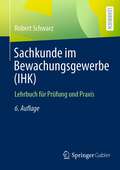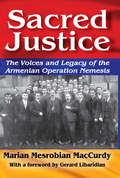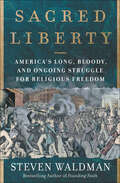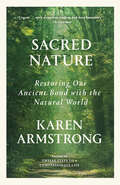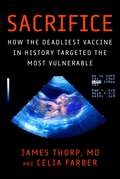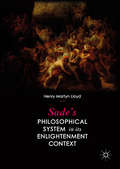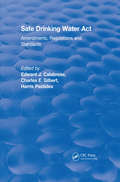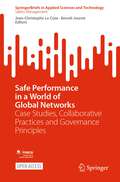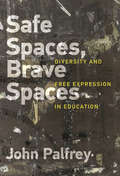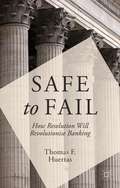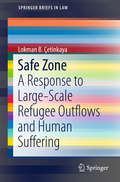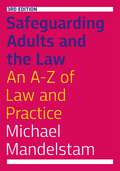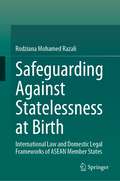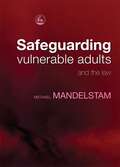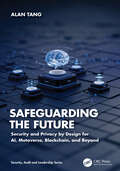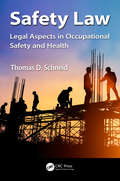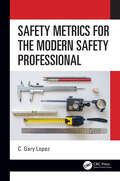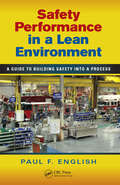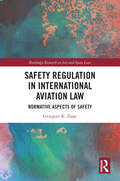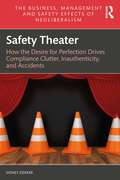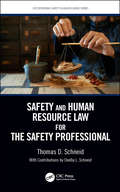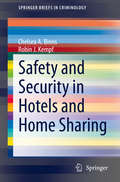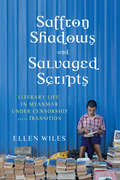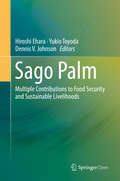- Table View
- List View
Sachkunde im Bewachungsgewerbe (IHK): Lehrbuch für Prüfung und Praxis
by Robert SchwarzDieses Lehrbuch behandelt systematisch alle Fachgebiete der IHK-Sachkundeprüfung nach dem aktuellen Rahmenstoffplan. Besonderen Wert hat der Autor dabei auf den oft als schwierig empfundenen Rechtsteil gelegt: Zahlreiche Abbildungen und Beispiele veranschaulichen die Gesetzestexte und ihre Bedeutung für die Praxis, erleichtern das Stoffverständnis und das Lernen. Übersichtlich und verständlich erläutert das Buch die Grundprinzipien der Rechtsordnung der Bundesrepublik Deutschland und deren Anwendung, wichtige Fachbegriffe und die Stellung der privaten Sicherheit. So bietet das Werk die optimale Prüfungsvorbereitung – Schritt für Schritt. Die überarbdeitete 6. Auflage entspricht dem aktuellen Rahmenstoffplan der DIHK vom Mai 2021.
Sacred Justice: The Voices and Legacy of the Armenian Operation Nemesis (Armenian Studies)
by Marian Mesrobian MacCurdySacred Justice is a cross-genre book that uses narrative, memoir, unpublished letters, and other primary and secondary sources to tell the story of a group of Armenian men who organized Operation Nemesis, a covert operation created to assassinate the Turkish architects of the Armenian Genocide. The leaders of Operation Nemesis took it upon themselves to seek justice for their murdered families, friends, and compatriots. Sacred Justice includes a large collection of previously unpublished letters, found in the upstairs study of the author's grandfather, Aaron Sachaklian, one of the leaders of Nemesis, that show the strategies, personalities, plans, and dedication of Soghomon Tehlirian, who killed Talaat Pasha, a genocide leader; Shahan Natalie, the agent on the ground in Europe; Armen Garo, the center of Operation Nemesis; Aaron Sachaklian, the logistics and finance officer; and others involved with Nemesis. Marian Mesrobian MacCurdy tells a story that has been either hidden by the necessity of silence or ignored in spite of victims' narratives—the story of those who attempted to seek justice for the victims of genocide and the effect this effort had on them and on their families. Ultimately, this volume reveals how the narratives of resistance and trauma can play out in the next generation and how this resistance can promote resilience.
Sacred Liberty: America's Long, Bloody, and Ongoing Struggle for Religious Freedom
by Steven Waldman“[A] compelling study of the most essential breakthrough of modernity: the right to believe, or not, as one wishes. A great book about a monumental issue.” —Jon Meacham, Pulitzer Prize–winning authorSacred Liberty offers a dramatic, sweeping survey of how America built a unique model of religious freedom, perhaps the nation’s “greatest invention.” Steven Waldman, the bestselling author of Founding Faith, shows how early ideas about religious liberty were tested and refined amidst the brutal persecution of Catholics, Baptists, Mormons, Quakers, African slaves, Native Americans, Muslims, Jews and Jehovah’s Witnesses. American leaders drove religious freedom forward—figures like James Madison, George Washington, the World War II presidents (Roosevelt, Truman, and Eisenhower) and even George W. Bush. But the biggest heroes were the regular Americans—people like Mary Dyer, Marie Barnett and W. D. Mohammed—who risked their lives or reputations by demanding to practice their faiths freely. Just as the documentary Eyes on the Prize captured the rich drama of the civil rights movement, Sacred Liberty brings to life the remarkable story of how America became one of the few nations in world history that has religious freedom, diversity and high levels of piety at the same time. Finally, Sacred Liberty provides a roadmap for how, in the face of modern threats to religious freedom, this great achievement can be preserved.“This is an important and fascinating book full of riveting stories, provocative insights, inspiring heroes, and some serious warnings. The American model of religious freedom should be the envy of the world. But if we don’t understand how we made this great ‘invention,’ we could easily squander the achievement.” —Reza Aslan, #1 New York Times–bestselling author of Zealot
Sacred Nature: Restoring our Ancient Bond with the Natural World
by Karen ArmstrongA profound exploration of the spiritual power of nature—and an urgent call to reclaim that power in everyday life.Since the beginning of time, humankind has looked upon nature and seen the divine. In the writings of the great thinkers across religions, the natural world inspires everything from fear to awe to tranquil contemplation; God, or however one defined the sublime, was present in everything. Yet today, even as we admire a tree or take in a striking landscape, we rarely see nature as sacred.In this deeply powerful book, the bestselling historian of religion Karen Armstrong re-sacralizes nature for modern times. Drawing on her vast knowledge of the world's religious traditions, she vividly describes nature's central place in spirituality across the centuries: from the Book of Job to St. Thomas Aquinas, from Lao Tzu to Wordsworth, and from the Stoics to Jainism and beyond. Throughout, she reveals how we have lost our sense of the divine, and how we can get it back.Armstrong explores the power of silence and solitude, the nature of personal sacrifice and the need to reconnect with sorrow and compassion—and how greater contact with and appreciation for nature can help us in unexpected ways. In bringing this age-old wisdom to life, Armstrong shows modern readers how to rediscover nature's potency and form a connection to something greater than ourselves.
Sacrifice: How the Deadliest Vaccine in History Targeted the Most Vulnerable
by Celia Farber James ThorpSacrifice documents the true story of Dr. James Thorp, a respected doctor of maternal fetal medicine, who in 2020, finds his entire profession has lost its mind, as well as its soul. Stunned to find his colleagues take the bribe money, drink the Kool-Aid, and push the COVID-19 shots, Thorp is one of the few Ob-Gyns to bear witness and broadcast the multitude of pregnancy complications including miscarriages, stillbirths, and many other tragic outcomes resulting from the shots. One of the few doctors from the maternal-fetal medicine realm who publicly protested the Covid shots as directly deadly to his patients—unborn babies—Thorp witnessed the carnage on a daily basis firsthand, documented it, published papers, and spoke up on countless media platforms, and in Senate hearings in Washington, DC. He was terminated, without any cause, and went on to campaign around the country to get the truth out. This is his story.
Sade’s Philosophical System in its Enlightenment Context
by Henry Martyn LloydThis book connects the philosophy of the Marquis de Sade—one of the most notorious, iconic, and yet poorly-understood figures within the history of European thought—with the broader themes of the Enlightenment. Rather than seeing himself as a mere pornographer, Sade understood himself as continuing the progressive tradition of French Enlightenment philosophy. Sade aspired to be a philosophe. This book uses intellectual history and the history of philosophy to reconstruct Sade’s philosophical ‘system’ and its historical context. Within the period’s discourse of sensibility Sade draws on the philosophical and the literary to form a relatively sophisticated ‘system’ which he deploys to critically engage with the two major strands of eighteenth-century ethical theory: the moral sense and natural law traditions. This work is of interest to: ‘Continental’ Philosophy, Critical Theory, French Studies, the History of Eighteenth-Century Philosophy, Literary Studies, the History of Moral Philosophy, and Enlightenment Studies.
Safe Drinking Water Act (CRC Press Revivals)
by Edward J. CalabreseThis new book covers drinking water regulations such as disinfectant by-products, synthetic organics, inorganic chemicals, microbiological contaminants, volatile organic chemicals, radionuclides, fluoride, toxicological approaches to setting new national drinking water regulations, and trihalomethanes. In addition, organic and inorganic compounds scheduled to be regulated in 1989 and new candidates for the 1990s regulations are detailed.
Safe Performance in a World of Global Networks: Case Studies, Collaborative Practices and Governance Principles (SpringerBriefs in Applied Sciences and Technology)
by Benoît Journé Jean-Christophe Le CozeThis open access book provides an analytical and critical outlook, by leading scholars, of the impact of various trends in the quality of collaboration and resulting safety outcomes that arise from the evolution of traditional integrated production within a single firm into a complex web of partnerships and supply chains. In the face of increasing fragmentation within industrial production and the associated rise in the complexity of inter-organizational communication and transaction, this book analyses causal factors such as cost pressures, globalization of demand, increasingly flexible resource allocation and work organization, changes in legal liability and the possibilities afforded by information technology. Various case studies focus on the effects of crossing boundaries between organizations, between different trades and professions and between countries, assessing the effect of variations in regulatory structures and national cultures. Furthermore, they illustrate the wide range of organizational forms to be found in high-hazard industries today and the impact, potential or real, of the variety of forms of partnership on safety and well-being at work. The contributors assess the effect of out-sourcing and of various forms of partnership and governance on safety at work and how they can be made to support the prevention of major accident hazards.
Safe Spaces, Brave Spaces: Diversity and Free Expression in Education
by John PalfreyHow the essential democratic values of diversity and free expression can coexist on campus. Safe spaces, trigger warnings, microaggressions, the disinvitation of speakers, demands to rename campus landmarks—debate over these issues began in lecture halls and on college quads but ended up on op-ed pages in the New York Times and the Wall Street Journal, on cable news, and on social media. Some of these critiques had merit, but others took a series of cheap shots at “crybullies” who needed to be coddled and protected from the real world. Few questioned the assumption that colleges must choose between free expression and diversity. In Safe Spaces, Brave Spaces, John Palfrey argues that the essential democratic values of diversity and free expression can, and should, coexist on campus. Palfrey, currently Head of School at Phillips Academy, Andover, and formerly Professor and Vice Dean at Harvard Law School, writes that free expression and diversity are more compatible than opposed. Free expression can serve everyone—even if it has at times been dominated by white, male, Christian, heterosexual, able-bodied citizens. Diversity is about self-expression, learning from one another, and working together across differences; it can encompass academic freedom without condoning hate speech.Palfrey proposes an innovative way to support both diversity and free expression on campus: creating safe spaces and brave spaces. In safe spaces, students can explore ideas and express themselves with without feeling marginalized. In brave spaces—classrooms, lecture halls, public forums—the search for knowledge is paramount, even if some discussions may make certain students uncomfortable. The strength of our democracy, says Palfrey, depends on a commitment to upholding both diversity and free expression, especially when it is hardest to do so.
Safe To Fail
by Thomas F. HuertasBanks are entering a new environment. Regulation and supervision are becoming tougher, so that banks will be less likely to fail. If a bank does fail, bail-in rather than bail-out will be the new resolution regime, so that investors, not taxpayers, bear loss. Safe to Fail sums up the challenges that banks will face and how they can meet them.
Safe Zone: A Response to Large-Scale Refugee Outflows and Human Suffering (SpringerBriefs in Law)
by Lokman B. ÇetinkayaUsing legal arguments consistent with international law, this book explores whether and under which circumstances a State (or States) may establish and militarily enforce safe zones in countries that produce large-scale refugee outflows so as to protect its (or their) own interests by averting said outflows, as well as to alleviate human suffering in today’s world of civil and internal warfare.Though large-scale refugee outflows have become an increasingly frequent problem in inter-state relations, international law offers no clear remedy. Accordingly, interpretation and adaptation of the existing rules and principles of international law, in addition to State practice and the jurisprudence of international courts, are required in order to find appropriate and lawful responses to such situations. The book examines countermeasures, necessity and humanitarian intervention as possible legal grounds to justify the establishment of safe zones.Since the proposal of a safe zone for Syria remains on the international community’s agenda, the specific conditions of this case are particularly addressed in order to assess the suitability and legality of a possible safe zone in Syria.
Safeguarding Adults and the Law, Third Edition: An A-Z of Law and Practice
by Michael MandelstamSafeguarding Adults and the Law, now in its third edition, sets this complex area of work within an extensive legal framework and provides many useful pointers for practitioners and students. It is now in an A-Z format, enabling quick reference to a wide range of civil and criminal law, and to legal case law.The book covers safeguarding duties under the Care Act 2014 and in particular the making of enquiries by local authorities, safeguarding adults boards, Department of Health guidance, human rights, regulation of health and social care providers, barring of carers from working with vulnerable adults, criminal records certificates, mental capacity, the High Court's inherent jurisdiction, undue influence, assault, battery, wilful neglect, ill treatment, self-neglect, manslaughter, murder, theft, fraud, sexual offences, modern slavery, domestic violence legislation, data protection and the sharing of information.The book focuses on how these areas of law, each with its own set of rules, apply to the practice of safeguarding adults. It contains numerous legal case summaries to bring the law to life. Fully updated, it reflects significant changes to civil and criminal law over the last five years.A critical introduction analyses serious challenges and issues inherent in the current culture of health and social care, and the implications for adult safeguarding.This book will be an essential resource for all those working in social care, health care and the police, as well as the many other agencies involved in safeguarding.
Safeguarding Against Statelessness at Birth: International Law and Domestic Legal Frameworks of ASEAN Member States
by Rodziana Mohamed RazaliThis book covers the essential aspects of prevention of childhood statelessness focusing on norms governing the subject through the rights to acquire a nationality and to birth registration, two vital safeguards to prevent statelessness among children. Its unique feature lies in its exposition of the international legal norms focusing on prevention of childhood statelessness and systematic analyses of domestic legal frameworks on nationality and birth registration of the 10 ASEAN Member States. This book is designed for a wide range of readers comprising academics, advocates, students, policy makers, and other stakeholders working on statelessness affecting children, especially in Southeast Asia.
Safeguarding Vulnerable Adults and the Law
by Michael MandelstamThe protection of vulnerable adults is a fast emerging area of work for local authorities, the NHS and other agencies. Safeguarding Vulnerable Adults and the Law, sets this within a comprehensive legal framework. The relevant law and guidance is extensive. It includes Department of Health guidance (No Secrets), human rights, the regulation of health and social care providers, the barring of carers from working with vulnerable adults, care standards tribunal cases, mental capacity, undue influence, assault, battery, wilful neglect, ill treatment, manslaughter, murder, theft, fraud, sexual offences, data protection and the sharing of information. The book focuses on how these areas of law apply to vulnerable adults, and brings together an extensive body of case law to illustrate this. Also covered is how local authorities and the NHS may themselves be implicated in the harm - through abuse, neglect or omission - suffered by vulnerable adults. For example, in terms of the gross lapses in standards of care, infection control, nutrition and basic dignity sometimes to be found in hospitals. All those working in community care, adult social work, health care and housing will find this book invaluable. Local authorities, the NHS, voluntary organisations and students will find this to be essential reading.
Safeguarding the Future: Security and Privacy by Design for AI, Metaverse, Blockchain, and Beyond (Security, Audit and Leadership Series)
by Alan TangIn the ever-evolving landscape of technology, emerging innovations like artificial intelligence (AI), blockchain, quantum computing, brain–computer interfaces (BCIs), and the Metaverse are transforming industries at an unprecedented rate. However, with these advancements come significant challenges, particularly in the realms of security and privacy. Safeguarding the Future: Security and Privacy by Design for AI, Metaverse, Blockchain, and Beyond by Dr. Alan Tang offers a comprehensive guide to navigating these challenges, providing a holistic framework to secure and protect the privacy of these cutting-edge technologies.What sets this book apart is its unique blend of technical depth and practical application. Dr. Tang leverages his extensive experience in privacy and security to deliver actionable insights that are crucial for organizations looking to stay ahead in this rapidly changing digital era. From aligning business strategies with security and privacy goals to implementing unified frameworks across multiple technologies, this book is an essential resource for executives, security professionals, and anyone involved in the deployment of emerging technologies.Key Features: In-Depth Analysis: Detailed exploration of the security and privacy risks associated with AI, blockchain, quantum computing, BCI, and other emerging technologies Unified Frameworks: A comprehensive, step-by- step guide to creating and operationalizing a unified security and privacy framework adaptable to various technologies Regulatory Alignment: Insights into aligning security and privacy practices with global regulations such as GDPR, CCPA, and ISO standards Case Studies and Real-World Examples: Practical case studies and examples that illustrate how to apply the concepts discussed in real-world scenarios Ethical Considerations: Examination of ethical issues surrounding the deployment of these technologies, with recommendations for addressing them proactively Future-Proofing Strategies: Guidance on preparing for future advancements and ensuring long-term compliance and security Whether you are a chief technology officer, chief privacy officer, data protection officer, or a security professional, this book equips you with the knowledge and tools needed to protect your organization’s data and ensure the secure deployment of emerging technologies. By adopting the principles outlined in this book, you can not only harness the full potential of these innovations but also safeguard the privacy and security of your organization and its stakeholders.
Safety Law: Legal Aspects in Occupational Safety and Health (Occupational Safety & Health Guide Series)
by Thomas D. SchneidSafety professionals must prepare every day to safeguard their employees in the workplace. Additionally, part of every safety professional’s responsibility is to safeguard their organization when a compliance inspection is conducted by federal, OSHA, or a state plan agency. Safety professionals are most organizations’ onsite safety and health "expert" and should be prepared far in advance of an inspection. They should be prepared during the inspection, and ready to defend the organization after the inspection. With the increase in the monetary penalties, the impact on an organization as a result of identified violations can be substantial. <P><P>This text prepares and educates safety professionals to address every phase from strategies, to compliance, to defenses, and provides a one stop location for information to address and prepare the safety professional if/when OSHA knocks at the door. Additionally, the safety function does not work in a vacuum. Other potential risks and potential liabilities from other laws, such as the ADA, which can impact the safety function, are also addressed. Safety professionals know that their organizations depend on their experience and expertise in their decision-making process. <li>Provides a legal prospective to prepare safety professionals for OSHA inspection and related potential risks <li>Case studies to enhance learning and state-by-state listing of applicable laws and regulations <li>Demonstrates an understanding of defense preparation and strategies for safety professionals <li>The safety professional’s "go to" book for compliance and inspections
Safety Metrics for the Modern Safety Professional
by C. Gary LopezThis book investigates the world of leading indicators and explores how they can be used effectively, providing 21st-century safety professionals with alternative metrics and guidance, which will enable them to make a difference in managing risk within an organization. The safety and health profession has been hindered by ineffective metrics for decades, with the primary metrics of choice being the OSHA incident rate and lost time accident rate. This narrow focus on what constitutes loss is not in line with the new concepts of managing the total risk that an organization faces. The book looks at indicators on a tactical level where they can be very effective in providing management with clear direction and "manageable" items they can utilize to elevate the safety efforts of an organization. It also explores the limitations of leading indicators at the strategic level and how they’re tied into the management merit review system to determine bonus and salary increase structures. It features measurements of areas of loss not usually considered by safety managers, suggests ways to use leading indicators, and promotes a departure from traditional "body count" thinking. This book will be of interest to safety professionals involved in risk management in the modern workplace.
Safety Performance in a Lean Environment: A Guide to Building Safety into a Process (Occupational Safety & Health Guide Series)
by Paul F. EnglishAs changing customer demands and shifting world markets continue to put a strain on businesses in all sectors, your business needs every advantage to stay competitive. Many people may think of Lean processes as suitable only for the manufacturing floor, but that couldn't be further from the truth. Safety Performance in a Lean Environment: A Guide t
Safety Regulation in International Aviation Law: Normative Aspects of Safety (Routledge Research in Air and Space Law)
by Grzegorz K. ZającThis book analyses the complex regulations and standards governing aviation safety on a global scale. Combining theoretical analysis with practical insights, it offers a comprehensive exploration of the normative foundations and real-world applications of international aviation law in ensuring air travel safety.From the foundational principles established by the Chicago Convention to the evolving challenges posed by technological advancements and geopolitical shifts, this book provides a nuanced understanding of the complex legal landscape shaping aviation safety. Through in-depth critical analysis, the book examines the role of key stakeholders – including states, international and regional organizations, and regulatory bodies – in promoting and enforcing safety standards. By exploring the intersection of legal theory and practice, this book sheds light on the practical implications of normative principles in addressing contemporary safety concerns, such as the COVID-19 pandemic. It encourages the regional institutionalization of civil aviation in order to improve local and regional aviation safety.The book will be of interest to researchers, practitioners, and policymakers seeking to navigate the legal frameworks and ethical considerations underpinning aviation safety law.
Safety Theater: How the Desire for Perfection Drives Compliance Clutter, Inauthenticity, and Accidents (The Business, Management and Safety Effects of Neoliberalism)
by Sidney DekkerHow is it possible that the desire for a perfectly safe world with perfectly safe workplaces helps generate the opposite? Safety Theater shows how our desire for perfection drives compliance clutter, inauthentic relationships with work-as-done, and new kinds of accidents. Written by the leading global voice on safety innovation today, Safety Theater takes us back to the Enlightenment and its aspiration toward a perfectible world through rationality and science, and explains how, by separating severity from injury rates two centuries later, we now hit our targets but miss the point. This hopeful, forward-looking book is the final volume in a three-part series on the effects of "neoliberalism," which promotes the role of the private sector in the economy.Showcasing a more caring kind of capitalism—where free markets are free in a frame; where horizontal coordination replaces hierarchical control; where shareholders are not the only stakeholders; and where value and prosperity are assessed in terms other than merely economic ones—the book platforms much of what is now known as "safety differently," and also allows us to think differently about our capacity to manage complexity (including its possible drift toward failure) and see our fellow human beings as resources for solutions, not as problems to control. Safety Theater introduces the socio-economic success and value system that distinguish Rhineland economies from Anglo ones. It explains how complexity can never be governed through hierarchy and compliance, but necessarily requires trust and horizontal coordination; offers a vision of humanity richer than Anglo-style capitalism can offer; and examines how Rhineland thinking values tripartite consultation (between workers, employers, and government) in ways that can help stem the worst effects of free market policymaking on the compliance clutter and drift into failure, as detailed in the previous two volumes in this trilogy.Sidney Dekker’s work—from his debut Field Guide to Understanding Human Error in 2001 to his recent Random Noise—always challenges readers to embrace more humane, empowering ways to think about work and its quality and safety. In Safety Theater, Dekker extends his reach once again, writing for all managers, board members, organization leaders, consultants, practitioners, researchers, lecturers, students, and investigators curious to understand the genuine nature of organizational and safety performance.
Safety and Human Resource Law for the Safety Professional (Occupational Safety & Health Guide Series)
by Thomas SchneidThe purpose of this text to provide a "one stop" source for safety professionals to acquire a general knowledge regarding not only the OSH Act but also laws and standards which impact the safety profession on a daily basis. The safety professional today does not work in a vacuum and decision-making can be impacted by a myriad of other laws. This new book will be the safety professional’s "go to" text to acquire a quick understanding of the particular law potentially impacting his/her daily activities. <p><p>Features <li>Includes safety laws as well as human resource laws <li>Presents new OSHA whistleblower actions <li>Encompasses updated contractor requirement under Wage and Hour laws <li>Covers new NLRA decisions and actions <li>Addresses e-commerce and social media issues involving the safety function
Safety and Security in Hotels and Home Sharing (SpringerBriefs in Criminology)
by Chelsea A. Binns Robin J. KempfThis brief comparatively reviews the security and safety features of hotels and home sharing services. It reviews crime data, laws, and applicable theories – such as defensible space, rational choice, and routine activity theories - to determine how responsibility for crime control and accident prevention in these industries is allotted.This analysis identifies key policy questions about the role of the home sharing hosts and guests in ensuring their own safety and security, which will be of interest to policy makers, researchers and practitioners in criminal justice and law enforcement, as well as those involved in the home sharing and hotel industries.
Saffron Shadows and Salvaged Scripts
by Ellen WilesUntil 2012, Myanmar had been ruled for fifty years by one of the most paranoid and repressive censorship regimes in history. The military junta enforced strict reading and writing restrictions in line with their socialist ideology and was terrified of writers who could trigger change.Transition has lifted the worst restrictions, initiating a new era in the country's literature and literary culture. Inspired by Ellen Wiles's hunt for contemporary writing while living in Myanmar in 2013, this book explores the experiences and recent output of nine Myanmar writers spanning three generations, featuring interviews and English-language translations of their work, along with political, legal, and artistic analyses. Wiles includes men and women, fiction and poetry, capturing the effects of political and cultural change as they rippled across different groups and genres. Her work contributes both to the general study of art under censorship and beyond to Myanmar's democratic renaissance.
Saffron Shadows and Salvaged Scripts: Literary Life in Myanmar Under Censorship and in Transition
by Ellen WilesThis book tells an ethnographic story of a secret literary culture that has recently emerged from its cocoon. Until 2012, Myanmar (also known as Burma) was ruled for fifty years by one of the most paranoid and repressive censorship regimes in history. The military junta enforced strict reading and writing restrictions in line with their ideology, feared writers' potential to trigger change, and did their best to keep Western books and influences out of the country. As part of an unexpected move toward democracy, the government has recently lifted the worst restrictions on reading and writing, giving rise to a new era in the country's literature and literary culture. While living in Myanmar in 2013, Ellen Wiles sought out the best of its contemporary writers and writing to begin uncovering the country's remarkable literary life and history. This book contains the experiences and recent output of nine Myanmar writers spanning three generations, featuring interviews and English-language translations of their work, along with political, legal, and artistic explorations. It includes men and women, fiction and poetry, reflecting the ripples of political and cultural change as they have moved across different groups and genres. A rare portrait of a people and place in transition, Wiles's work contributes both to the study of literature and culture in Myanmar and to the general study of art under censorship.
Sago Palm: Multiple Contributions To Food Security And Sustainable Livelihoods
by Dennis V. Johnson Hiroshi Ehara Yukio ToyodaThis book is open access under a CC BY 4. 0 license. This book addresses a wide variety of events and technologies concerning the sago palm, ranging from its botanical characteristics, culture and use to social conditions in the places where it is grown, in order to provide a record of research findings and to benefit society. It discusses various subjects, including the sago palm and related species; differentiation of species of starch-producing palm; habitat, morphological, physiological and growth characteristics; culture and management; productivity of carbon dioxide; starch extraction and manufacture; characteristics and utilization of starch; and cultural anthropological and folkloristic aspects. Problems such as food shortages due to increasing populations, global warming and climate change, and decreasing reserves of oil and other underground resources, have become more pressing in recent years. In the context of these problems, the book examines the role of the sago palm in sustainable food production, in the manufacture of other foodstuffs, as a raw material for ethanol and in the manufacture of biodegradable plastics. In addition to academics, this book will be useful to researchers and government officials working for international agencies, national governments, municipalities, and other research organizations; technicians, researchers, managers, entrepreneurs, and others working in industries such as agriculture, plant production, food production, manufacturing, chemical engineering, energy production, and distribution.
